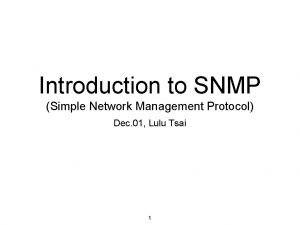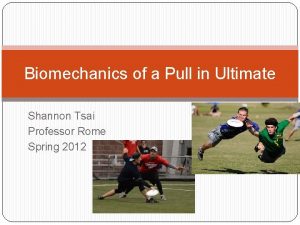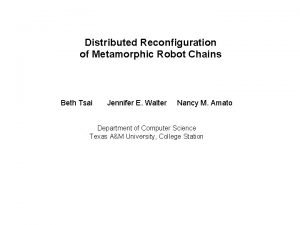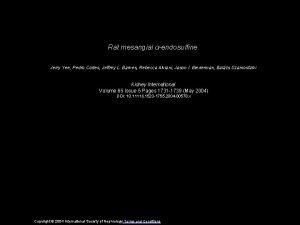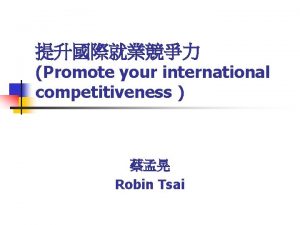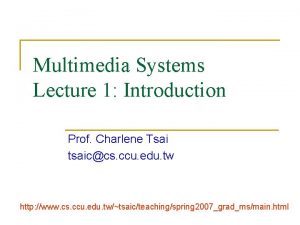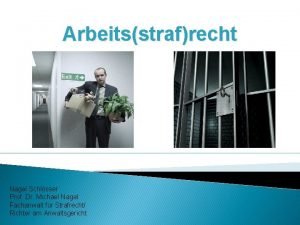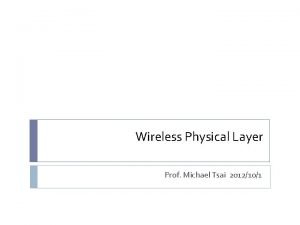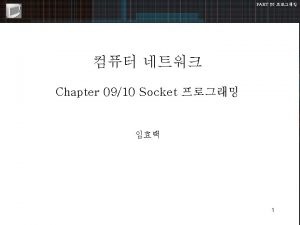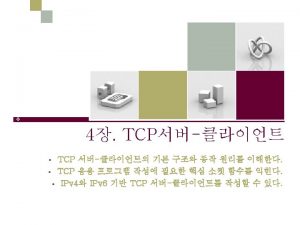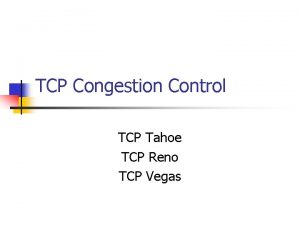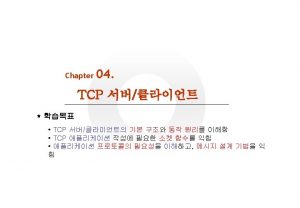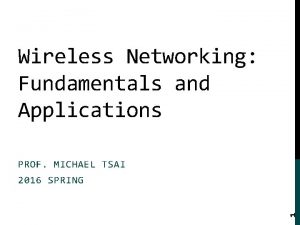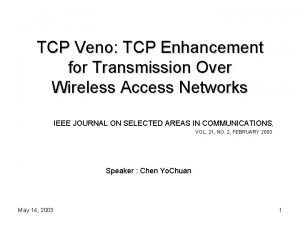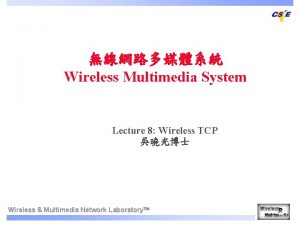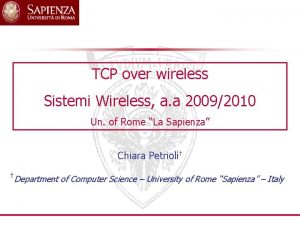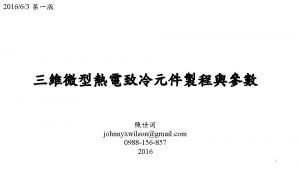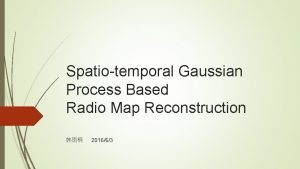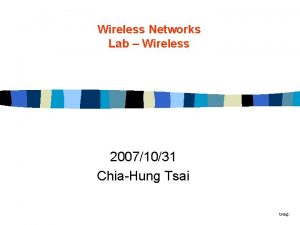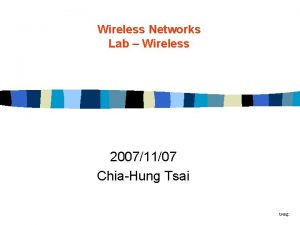TCP over Wireless PROF MICHAEL TSAI 201663 TCP

















- Slides: 17

TCP over Wireless PROF. MICHAEL TSAI 2016/6/3

TCP Congestion Control (TCP Tahoe) • Only ACK correctly received packets • Congestion Window Size: Maximum number of bytes that can be sent without receiving acknowledgements. • Larger window size == faster rate • Three major mechanisms: 2 • Slow start • Congestion avoidance • Fast retransmit

Slow start + congestion avoidance Source Destination • Congestion window size = 1 initially. • Ssthresh: slow start threshold • Slow start: For each received ACK (with a new seq. no. ), the window size is exponentially increased (e. g. , doubled). (when the window size is smaller than ssthresh) • Congestion avoidance: After reaching ssthresh, the window size is linearly increased. 3 • Additive Increase

Slow start + congestion avoidance • TCP calculates expected round trip time (RTT) and its deviation • Timeout: wait time > expected RTT + 4 * deviation • Timeout: it signals a packet loss due to congestion (? ) • When a timeout happens, TCP Tahoe does the following: 4 • Dropping ssthresh into half the current window or 2 (multiplicative decrease) • Resetting its window size to 1 + enter slow start • Double round trip timer

Pseudocode 5 Initially: cwnd = 1; ssthresh = infinite; New ack received: if (cwnd < ssthresh) /* Slow Start*/ cwnd = cwnd + 1; else /* Congestion Avoidance */ cwnd = cwnd + 1/cwnd; Timeout: /* Multiplicative decrease */ ssthresh = cwnd/2; cwnd = 1;

The big picture (with timeouts) cwnd Timeout AIMD Timeout Initially: cwnd = 1; ssthresh = infinite; New ack received: if (cwnd < ssthresh) /* Slow Start*/ cwnd = cwnd + 1; else /* Congestion Avoidance */ cwnd = cwnd + 1/cwnd; Timeout: /* Multiplicative decrease */ ssthresh = cwnd/2; cwnd = 1; AIMD ssthresh Slow Start Time 6 Slow Start

Fast Retransmit • Resend a segment after 3 duplicate ACKs cwnd = 1 • Duplicate ACK means that an out-of sequence segment was received cwnd = 2 segment 1 ACK 2 segment 3 ACK 3 • Notes: • ACKs are for next expected 3 duplicate ACKs packet • Packet reordering can cause duplicate ACKs • Window may be too small to get enough duplicate ACKs ACK 4 segment 5 segment 6 segment 7 ACK 4 7 cwnd = 4

Big problems for TCP • High bit error rates: up to 10^-5 bit error rate. Lots of lost packets due to bit errors. • Disconnections: • Handoff: mobile devices move between base stations / access points. • Mobility: mobile devices move in and out of range of the transmitter. • Fading: signals blocked by buildings or other obstacles. • Round trip time could significantly vary. (Indication of packet loss could be inaccurate) 8 • Big problem: packet losses are not necessarily due to congestion! (the assumption of the original TCP)

9

Classification of Solutions • Link layer • Goal: improve the quality of the link layer, hide the losses from TCP • “Local problems should be solved locally” • End-to-end • Additional considerations are added to TCP to improve its performance • Limited performance improvement • No modification on the hosts is required • Split-connection 10 • Wireless usually the last link to the mobile host • Isolate that wireless link with the rest of the path (wired) • Two TCP connections, bridged at the wireless gateway • Use regular TCP for wired links • Use a special protocol designed specifically for that wireless link

11 Indirect TCP (I-TCP)

12 Indirect TCP (I-TCP)

I-TCP • Advantages • No changes in the fixed network / hosts (TCP) • Wireless transmission errors do not propagate to the wire-line network • Simple and effective • Disadvantages 13 • End-to-end semantics become less clear • Higher end-to-end delay due to buffering and forwarding at the gateway

Snooping TCP • Transparent extension of TCP within the gateway • Hides wireless losses from wired host • Buffer packets sent to the mobile host • Local retransmission: lost packets on the wireless link, for both directions, are retransmitted immediately by the mobile host or foreign agent • Wireless gateway snoops the packet flow so that it can cover up signs of packet loss 14 • Recognizes ACK in both directions and suppresses duplicate ACKs

15 Snooping TCP

Snooping TCP • Data transfer to the mobile host • FA buffers data until it receives ACK from the MH • FA detects packet loss via duplicated ACKs or timeout • Data transfer from the mobile host • FA detects packet loss on the wireless link via sequence numbers • FA answers directly with a NACK to the MH • MH can now retransmit data with only a very short delay • Integration of the MAC layer 16 • Similar mechanisms often exist in MAC

17 Snooping TCP
 Itcp in mobile computing
Itcp in mobile computing Telecommunications the internet and wireless technology
Telecommunications the internet and wireless technology Jerry tsai tutor
Jerry tsai tutor Lulu tsai md
Lulu tsai md Site:slidetodoc.com
Site:slidetodoc.com Fast radio burst
Fast radio burst Wen-hsuan tsai
Wen-hsuan tsai Shannon tsai
Shannon tsai Beth tsai
Beth tsai Eddie tsai
Eddie tsai Vukovar rat
Vukovar rat Robin tsai
Robin tsai Charlene tsai
Charlene tsai National professor
National professor Michael nagel rechtsanwalt
Michael nagel rechtsanwalt Prof michael woodward
Prof michael woodward Over the mountains over the plains
Over the mountains over the plains Siach reciting the word over and over
Siach reciting the word over and over



